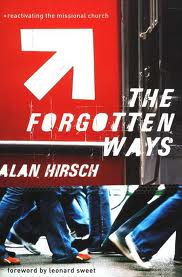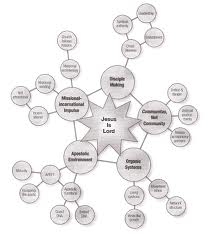 In my last post, I shared my favorite fiction books from 2012. Fiction books can be very influential as well, but there was one non-fiction book that helped with a paradigm shift in how I thought about church and its mission.
In my last post, I shared my favorite fiction books from 2012. Fiction books can be very influential as well, but there was one non-fiction book that helped with a paradigm shift in how I thought about church and its mission.
The Forgotten Ways: Reactivating The Missional Church by Alan Hirsch was recommended to me over a year ago by my friend and former pastor Brian Harrison. I didn’t read it until this year when my friends and I started into our Outreach Saga. A group of us had left our former church and were looking into what God had for us.
As we started to meet together and tried to hear from the Lord each week, I was also reading this book. It truly opened my eyes to ideas that I hadn’t considered in a fleshed out manner before. Sure, through intuition and talking with other people I had touched on ideas from The Forgotten Ways but I wasn’t getting the full picture.
Hirsch discusses how the model of Christendom we operate in nowadays in modern evangelical culture (for the most part) is not necessarily how the early church (up to 300 AD) did things. From 300 AD to now the church developed hierarchy and structure that was adopted from Roman systems. They worked in a Christian culture context of Europe in the Dark and Middle Ages, even through the Renaissance and Reformation. However, now that our culture is post-Christian and pluralistic, it cannot meet the changing forces in the world in an adequate way.
The majority of the book describes his theory on how church should operate. Through the complex diagram to the right, he shows how the church needs to function. Stemming from the Lordship of Jesus are the five hubs that continue to expand out and encompass the life of a Christian and the community of believers.
Hirsch has worked in missional fields for a long time and has spent a lot of effort into this study. From the Biblical basis to historical activity and modern theory involving organic systems, he brings a thorough and convincing argument for the need to discover forgotten ways and to fully reactivate the life believers need to have today to fully reach the people out there.
In writing this post I am not doing the book justice in a short summation. Perhaps my testimony will help spell it out. As I read the book, I realized that as we tried to reach out to a needy sub-group in our community, we needed to be willing to risk and try new things in order to touch the people. Instead of being a controlled environment where one person (the pastor) speaks and runs the meeting, we’re developing a time of sharing with each other from the Word and our own testimonies. In this way everyone in the meeting has the potential to share something that another person may desperately need. I know I don’t have all the answers in life – that I don’t have the exclusive on God. In relying on the body of Christ to be the body, I’ve seen the strength it brings by allowing others the opportunity to step up when they have what is needed at the time.
I had a reawakening through reading this book and studying Scripture alongside it. I haven’t had a book challenge me like this in many years. It is an easy choice for me to recommend it to anyone who’s wondering if there are better ways of doing “church.” There are better ways, but we’ve just built human structures onto things that should be organic and not just formed into boxes. For an introduction into this, I can’t do better except to highly suggest reading The Forgotten Ways and seeing if it speaks of His truth and the reality of the world today. I think it does both.
So here’s to 2013. May there be many excellent books in your future, and may you dare to take a risk for Jesus in your life in the coming year.
—
